Abstract
Heterochromatin Distribution Pattern in Aid of Understanding Plant Species Inter-Relationships
Direct staining using Chromomycin A3 (CMA) and DAPI (DAPI) fluorochromes has been widely adopted for studying the heterochromatin in various plant taxa. CMA and DAPI show preferential binding for GC- and AT-rich heterochromatin regions respectively and can divulge the amount, type, location of heterochromatin regions and thus revealing the relative AT- and/or GCrich fractions in the chromatin. This short commentary documents the efficacy of CMA and DAPI binding pattern in comparative analysis of relative AT- and/ or GC-rich repetitive heterochromatin fraction(s), thus giving an insight about species diversification and evolutionary pattern in many plant taxa besides helping in assessment of genetic fidelity in micropropagated plants.
Author(s):
Judith Mary Lamo, Soibam Purnima Devi, Kheisham Merita Devi, Shamurailatpam Anju, Satyawada Rama Rao
Abstract | Full-Text | PDF
Share this

Google scholar citation report
Citations : 5001
Electronic Journal of Biology received 5001 citations as per google scholar report
Electronic Journal of Biology peer review process verified at publons
Abstracted/Indexed in
- Google Scholar
- China National Knowledge Infrastructure (CNKI)
- CiteFactor
- Electronic Journals Library
- Zoological Records
- WorldCat
- Proquest Summons
- Publons
- MIAR
- Openaccessarticles.com
- Secret Search Engine Labs
Open Access Journals
- Aquaculture & Veterinary Science
- Chemistry & Chemical Sciences
- Clinical Sciences
- Engineering
- General Science
- Genetics & Molecular Biology
- Health Care & Nursing
- Immunology & Microbiology
- Materials Science
- Mathematics & Physics
- Medical Sciences
- Neurology & Psychiatry
- Oncology & Cancer Science
- Pharmaceutical Sciences


